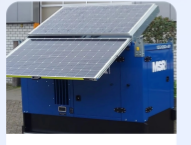Transitioning to clean energy is no longer just an environmental imperative; it’s also a sound business strategy. As concerns about climate change and fossil fuel depletion grow, the adoption of renewable energy sources like solar and wind power is accelerating. This comprehensive guide aims to provide insights into these two pivotal Cleanenergie sources, their benefits, and their potential to transform our energy landscape.
The Rise of Solar Power
Solar energy has emerged as one of the most accessible and scalable forms of renewable energy. Harnessing the power of the sun, solar panels convert sunlight directly into electricity through photovoltaic cells. This technology has seen significant advancements in efficiency and cost reduction over the past decade.
How Solar Power Works
Solar panels are composed of numerous photovoltaic cells made from semiconductor materials, typically silicon. When sunlight strikes these cells, it knocks electrons loose, creating an electric current. This direct current (DC) is then converted into alternating current (AC) via an inverter, making it suitable for home and commercial use.
Benefits of Solar Energy
1. Sustainability: Solar power is inexhaustible as long as the sun shines. It reduces reliance on finite fossil fuels and minimizes carbon emissions.
2. Cost-Effectiveness: Advances in technology have brought down the cost of solar panels, making it more affordable for both residential and commercial applications. Additionally, many regions offer tax incentives and rebates for solar installations.
3. Energy Independence: Solar energy allows individuals and businesses to generate their own power, reducing dependence on the grid and enhancing energy security.
The Potential of Wind Energy
Wind energy is another cornerstone of the renewable energy sector. Utilizing large turbines, wind energy converts kinetic energy from wind into mechanical power, which is then converted into electricity. This technology is particularly effective in areas with consistent wind patterns.
How Wind Power Works
Wind turbines capture wind with large blades, turning a rotor connected to a generator. The kinetic energy from the wind is transformed into mechanical energy as the rotor spins. This mechanical energy is then converted into electrical energy by the generator.
Benefits of Wind Energy
1. Environmental Impact: Wind energy produces no greenhouse gas emissions during operation, making it an environmentally friendly option.
2. Scalability: Wind farms can range from a few turbines to large-scale installations with hundreds of units, providing flexibility to meet varying energy demands.
3. Economic Growth: The wind energy sector has the potential to create numerous jobs in manufacturing, installation, and maintenance, contributing to economic development.
Integrating Solar and Wind Power
Combining solar and wind energy systems can offer a more reliable and consistent energy supply. Since solar power is generated during the day and wind power can be harnessed both day and night, the two sources can complement each other. Hybrid systems that integrate both forms of energy are increasingly being adopted to maximize efficiency and output.
Overcoming Challenges
While the benefits of solar and wind energy are compelling, there are challenges to consider. Both technologies require significant initial investments and may face regulatory hurdles. Additionally, energy storage solutions are needed to address the intermittent nature of these sources, ensuring a steady energy supply even when the sun isn’t shining or the wind isn’t blowing.
Future Prospects
The future of clean energy looks promising with ongoing advancements in technology and increasing global commitment to sustainability. Innovations in energy storage, smart grids, and energy-efficient technologies are expected to further enhance the viability of solar and wind power. As these systems become more integrated into our energy infrastructure, they will play a crucial role in reducing our carbon footprint and fostering a sustainable future.
Conclusion
From solar to wind, the transition to clean energy (Clean energie) sources is not just a trend but a necessary evolution. Embracing these technologies offers a path to a more sustainable, resilient, and economically viable energy landscape. By understanding and investing in solar and wind power, we can collectively work towards a cleaner, greener future for generations to come.
From Solar to Wind: A Comprehensive Guide to Clean Energy Sources
